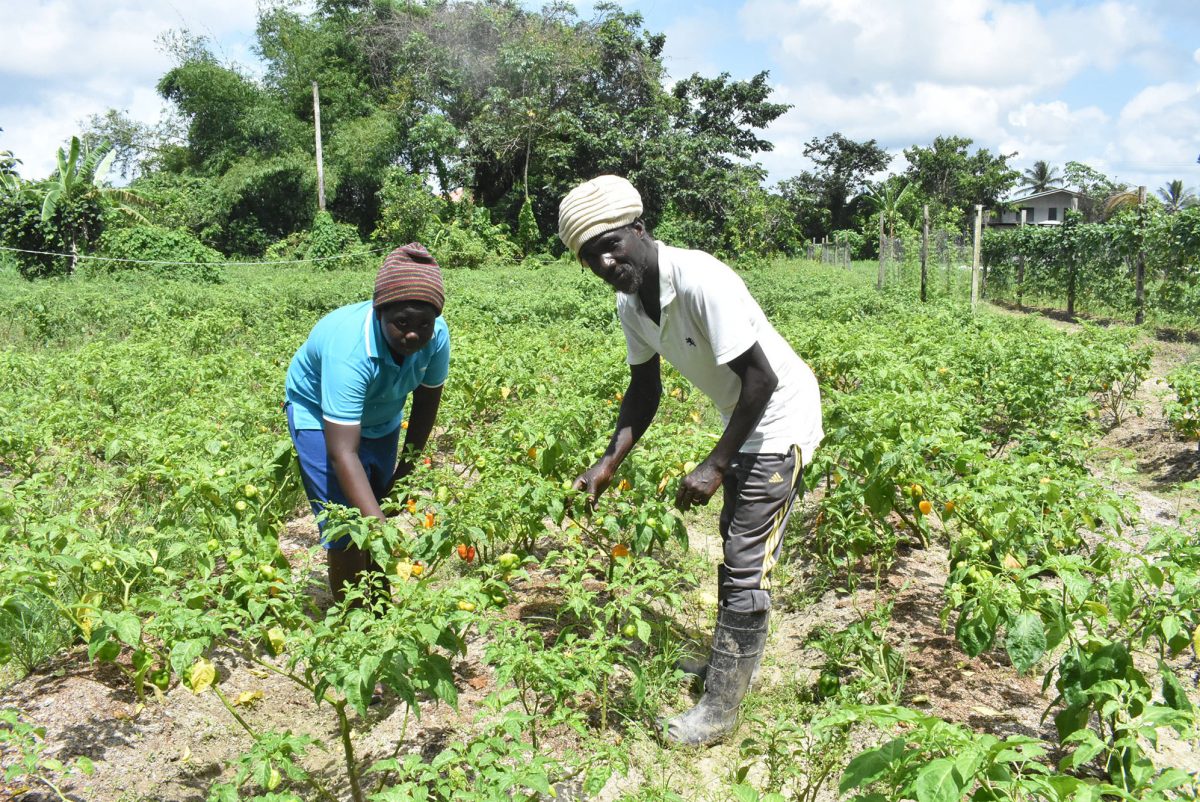Rawle Clarke lives and works at Coverden, a community situated along the East Bank, about forty-five minutes’ drive from Georgetown. He has lived at Coverden for about thirty years and has been farming ever since he went there to live. He says, however, that he only “became a serious farmer about ten years ago.” We spoke, initially, under his house which shares the acre of land on which he farms. Clarke says the one-acre is part of family land.
It is not difficult to determine that Clark takes his farming seriously. His farm comprises neat rows of Scotch Bonnet pepper, an assortment of sweet pepper, bora, and carilla. These are his cash crops. The remainder, lesser amounts of sugar cane and other food crops are for home use. “Farming is hard work, but I love farming and it brings in the money,” Clark says, emitting a tone of deliberateness as he perforates the soil with a menacing-looking pitch fork. There is little sign of contemporary technology here. It is mostly about conventional, functional tools and about sweat. A cutlass and a determined hand, he says, still clears the land and the pitchfork still prepares the beds to prepare the seeds. It takes him an entire day to prepare three plant beds. If he used a hand-held plough the task would take about an hour. The limitation is “a question of money.” An investment intended to secure the funds to acquire the hand-held plough had fallen through.
Two years ago, the fifty-year-old Clark had been cultivating cabbages and he says, had been “doing well.” The money, he reminisced, “was good,” so he took a decision to make an enormous leap from cultivating 500 heads to twenty thousand heads! Two things happened. Almost simultaneously, his farm was visited by disease that ravaged the entire crop of cabbage. At the same time the uncertainties associated with the advent of COVID-19 created doubt about the immediate-term future of the market. What remained after the crop disease and the vicissitudes of COVID-19 had come and gone were 300 head of cabbage which he eventually sold. The cabbage catastrophe, he says, “broke” him. “I’m still reeling. I had invested about $100,000. While this might seem like a small amount it was a lot for me.”
The limits to his resources means that Clark must turn mostly to his colleague farmers for guidance in crop disease-related matters. He is, he says, part of a network of farmers who share challenges with each other and he benefits from the support of his more experienced counterparts who always stand prepared to share their knowledge with him.
Clark discovered earlier this year that his sweet-pepper trees were not “bearing as it should.” He sought the guidance of other farmers and has returned to the routine of reaping sweet pepper twice every week.
We probed Clark to determine the considerations that impact the cultivation choices that he makes.
The likely prices on the market are, he says, the main consideration. “Prices might not be good all year round but the good times tend to compensate for the bard ones.” His decision to plant sweet peppers and Scotch Bonnet peppers was, he says, based on prices and encouragement from his customers. Contextually, he noted that, customarily, the Scotch Bonnet pepper is a “high price pepper.” It takes about three months from cultivation for them to be harvested; after that you can harvest peppers twice weekly. In other words you have a weekly income there.” Clarke sells his peppers to a bulk buyer and to business houses and homes in Coverden and Soesdyke.
Loss of crops on account of flooding is an occupational hazard of farming in Clark’s ‘neck of the woods’. Clarke however, is philosophical. “This is my livelihood. This is where I get my money. This is what I know. After the floods I have to get up and go again.”
He recalls a decade ago when a major flood brought a sudden halt to a particularly lucrative ‘run’ deriving from the cultivation and sale of plantains. The disaster had arisen out of the fact that a canal had been blocked in order to rehabilitate a bridge. “The water backed up and killed all the plantain suckers.” He didn’t say whether the planners involved in the renovation of the bridge had bothered themselves to inform him of the likely consequences for his plantains. Afterwards, he repeated that story of the disease that had destroyed his cabbages last year. “I have not yet recovered from that incident, but here I am planting sweet peppers. The price is good and I am anticipating about three hundred pounds from this crop.”
‘Down the road,’ Clarke says, he wants to increase the range of his crops under cultivation. Celery and other seasonings are ‘on the cards.’ He looks to the skies. “I am concerned that the weather is unpredictable. It seems that rain is falling more intensely these days. We may have to change the way we farm. There is a need to employ smart agricultural methods including Shadehouse farming.
That will require investment.” He says that the Small Business Bureau may be an option. A water sprinkler system designed to reduce the manual monotony has been his latest investment. Apart from a casual worker, he occasionally presses his thirteen-year-old son Micaiah (who is out of routine school on account of the COVID-19 pandemic) into service.
On the Coverden property lies building material, seemingly idle. Clark gestures at the material and says that his aim is to complete the building of his home whilst living in what has already been completed. He does not plan to seek the intervention of a commercial bank.
All of this still leave time to cultivate sugar cane and when time permits, press his juicer into service and sell cane juice. The noise of the working juicer serves as his own unique advertising mechanism. “The sound alerts his community and persons would come over to buy the cane juice.” He produces cane juice, he says, in batches of forty two litres and “the lot” is gone in “no time.”
Mr. Clarke can be contacted on telephone number 664-1409








